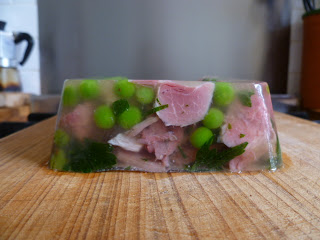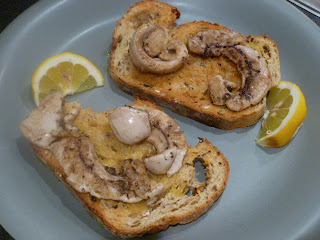It may have felt like high summer for much of the past week or so, but we really have only just got spring into full swing, with trees bursting into leaf and blossom, birds singing their little hearts out and British asparagus and Jersey Royal potatoes hitting the supermarket shelves. These items, along with the slightly earlier and previously mentioned purple sprouting broccoli are true harbingers of spring, marking the arrival of that season in the kitchen much more effectively than any single swallow makes a summer – if for no other reason than that the swallows are just getting here too early. I saw my first single swallow of the year the weekend before last (on a trip up to the Wirral for a family do, and they can’t possibly be arriving on Merseyside first…), just a day or two after my first sighting of Evesham asparagus. I blame global warming.
In fact I can’t help but think that global warming is having its effect on Asparagus too. I could have sworn that the British season started in late April, even the beginning of May and ran through to mid June, and that would appear to be confirmed by the home page of the British Asparagus association website, but it seems to get under way much earlier than that these days. As I say, it was a couple of weeks ago now that I saw my first bunches of the year on display - although I didn’t get a chance to bring any home and cook with it till last week (sorry for being slack…). Mark Hix (who always makes a feature of asparagus season – and Jersey Royals on his restaurant menus) ran his annual asparagus celebration in his weekly Independent column on April 2nd this year, compared to the 12th in 2008, which did appear to support my earlier-every-year-global-warming thesis, until Google revealed that in 2010 it appeared as early as the 27th of March. March! Although that one did say the first spears would be cropped any day now, rather than reporting that they’d already arrived… Hugh Fearnley Whittingstall in the Guardian left it as late as May 9th in 2009, but he doesn’t seem to make an annual event of it, so it’s impossible to deduce a pattern from that.
Whatever, I’m quite sure that the British asparagus season starts substantially earlier, and lasts much longer than it ever used to, which quite likely does have something to do with global warming, but probably has as much to do with growers cashing in on the recent rise to fashionability of both British food and local, seasonal eating. Both of which asparagus could be cast as poster vegetable for. Because British asparagus, particularly that grown in the Vale of Evesham is celebrated as being the world’s best, it does, still, have a limited season, and it is one of those food stuffs for which freshness is most crucial (all of which can also be said, incidentally, of Jersey Royal potatoes). So, without wishing to appear to be a slave to fashion, or jumping on to the first passing faddy bandwagon, I would encourage anyone to make the most of the British asparagus while it’s here. And that extends to not making a habit of buying the imported stuff the rest of the year (or even making a habit of not doing so. Not that there is anything inherently evil about, say, Chilean asparagus, although more militant anti-food-milers would no doubt have something to say about that.
As for what to do with your asparagus, it’s not so much a question of suggesting recipes, as things to have it with. As far as cooking goes*, it really is a question of keeping it simple, either steaming it or boiling it, for just three or four minutes depending on how hefty the spears are. Or chargrilling it on a griddle pan or, perhaps best of all, the barbecue. Serve it simply dressed with salt, pepper and melting butter if you don’t have a dairy allergic girlfriend, or a vinaigrette if you do – or simply if you prefer, and why shouldn’t you? Similarly a poached egg, mayonaise or hollandaise are classic accompaniments that only work in this house if I’m doing myself a solo lunch (and then I am never, ever going to go to the bother of hollandaise, believe me, although it’s no secret to readers of this blog that a poached egg might easily make an appearance. Or even, I have no shame in admitting, a jar of Hellmann’s out of the fridge). My first asparagus of this year was just such a lunch, steamed alongside a poached egg on a piece of brown bread, with its crusts removed and lightly fried in olive oil. Don’t tell Becca, but I would be amazed if this first asparagus experience of the year get’s bettered - asparagus and a poached egg being a combo of preternatural perfection.
A risotto is good, made, plain, in the usual way and with cooked asparagus spears stirred in right at the end, or, better, in my opinion, because it will taste more asparagussy (If I can say that), with the bottom half (the thicker, tougher, half, even after trimming) of each asparagus spear sliced into 1cm lengths, and these pieces thrown in with the onion or shallots at the beginning of the risotto making process, then the tips thrown in to cook with the rice towards the end, for the last ten minutes or so (less if the spears are slender).
Another great combo, if not quite in the poached egg category, if only for lack of dunking potential, is asparagus and prawns. And this is where the barbeque comes into its own. First marinade the prawns, shell on, in salt, pepper, finely sliced garlic and fresh red chilli (or dried chilli flakes would be good too), grated lemon zest, the juice of the lemon and plenty of olive oil. Throw in a handful of chopped fresh herbs too if you have them, I used parsley and dill here. Leave them to marinate in the fridge for ideally a couple of hours, or at the very least while your barbeque is heating up. Toss the asparagus in a similar, but simpler marinade - definitely leave out the garlic and chilli, but the lemon and parsley would work, or just the salt, pepper and olive oil would be fine. Then simply grill the prawns whole on the barbecue, then once they’re done and cooling down enough to handle, grill the asparagus spears. They’ll need little more than a minute on each side on an averagely hot barbecue, if that. For those who aren’t allergic, a dipping sauce of garlic, chilli and lemon mayonnaise would work nicely with this – just finely chop the garlic and chilli, and grate a little lemon zest into a small bowl or ramekin of mayo, with a squeeze of lemon juice stirred in.
I had intended to get the asparagus and Jersey Royals together in a salad, but found we’d used up all the asparagus before getting round to it. No matter, a few chopped stems and a couple of the purple flowers from the pot of chives on the balcony substituted most effectively, not to say prettily, for the asparagus, tossed together with the still warm boiled potatoes, along with some shredded smoked streaky bacon fried up with a handful of pine nuts, sliced red pepper, fennel, celery, spring onion and cucumber, all dressed in salt, pepper, the juice and grated zest of half a lemon and some good tasty extra virgin olive oil.
* As far as preparation it’s simply a matter of removing the woody ends of the stems. Obviously this can be done by trimming them with a knife, but that involves a lot of guesswork and most probably the wastage of a fair proportion of perfectly good tender spear (or the picking out from your teeth some unpleasantly fibrous stub ends). I find the best, and easiest, way is to snap them by hand: simply grip each spear lightly with a hand at each end, thumbs resting under the middle (or a bit more towards the thick end) of the spear, and bend downwards. The spear will naturally shear at the point where delicious tenderness becomes woody inedibility.













































